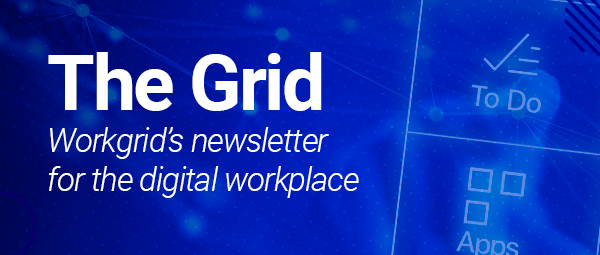The digital workplace - a priority for the future of work
More than a year ago the nature of work changed significantly as the pandemic forced businesses to quickly enable efficient remote work for all employees. Despite that disruption, however, it was always assumed that workers would eventually return to “normal,” i.e. working in a physical office.
But all of that has changed. The pandemic has gone on for far longer than anyone expected and there’s no end in sight. As a result, employees have come to appreciate the advantages of working from home. In fact, recent studies indicate that 65% or workers want to continue working remotely full-time and 58% would even look for other employment if forced to return to the office.
![[asset] remote-office-future-of-work](https://images.ctfassets.net/z7p73u8c0thn/3zAltRAMDiVmWfcSvQpKGi/e3a4cdbc030d82d25f7343fe795274c4/remote-office-future-of-work.png?w=600&h=350&q=60&fm=png&bg=transparent)
Surveys indicate that only 2% of employees are interested in returning to an office full-time. (Source: Human Resource Executive, "Requiring Employees to Return to the Office? Get Ready for Them to Quit," April 27, 2021)
Whether organizations opt for a fully remote or hybrid work model, the physical workplace has been deprioritized as the cornerstone of the work experience. It’s a scary sounding prospect that has no precedent. How can a business run if employees aren’t in an office and don’t have the vital relationship building exercises of watercooler chats and impromptu discussions in the hallway?
The reality is people no longer have to be in the same physical space to effectively communicate and engage with each other. The digital workplace has all of that covered and will take the place of the physical workplace when it comes to bringing people and work together.
Now that doesn’t mean organizations should continue the practice of simply delivering an endless array of purpose-built applications to assist employees with each individual work function.
That approach might have been initially successful when organizations were forced to make a sudden shift to remote work and anywhere operations, but it also resulted (unintentionally) in a complex maze of end-user technologies supporting legacy processes and workflows that were bad for the employee experience.
4 key areas of the digital workplace to assess and address:
1. Attention management & focus
Employees are saddled with too many technologies, making it difficult to focus on meaningful work. This is particularly true of the collaboration tools that were implemented during the pandemic. It’s common to have multiple methods of communicating among teams, including Slack, MS Teams, email, etc. And while this arguably provides flexibility and maybe even improved collaboration, this approach has also resulted in a distracted workforce that’s bowing under the constant stress of context switching.
![[gif] workgrid-smart-notifications](http://images.ctfassets.net/z7p73u8c0thn/2Jiut8AmLnCvIuhfKPy67j/2d306cdcb13b48bbce3d1aa9d130d8e9/workgrid-smart-notifications.gif)
Promoting the right information at the right time in a centralized location is the best way to help employees focus
2. Complex workflows & processes
Managing the confusion of inconsistent workflows and processes (whether new or legacy) created by an abundance of disparate applications is a constant drain on productivity. Requesting time off is a perfect example of a legacy process in desperate need of an overhaul. It’s a frustrating experience that requires multiple steps in several systems and it steals time away from more important work.
![[asset] onboarding-workflow-manager-view](https://images.ctfassets.net/z7p73u8c0thn/3ZLpdGxSz2VRzALQlt5BF8/93fd7199e0a780375d48390112dd5588/onboarding-workflow-manager-view.png?w=600&h=350&q=60&fm=png&bg=transparent)
Onboarding is another good example of a complex process that could create a better employee experience if improved.
3. Data silos & poor quality of data
With no single source of truth for the information employees need to work effectively, much of their time is spent locating, validating, and formatting data – time that would be better spent on the job they were hired to do.
![[asset] workgrid-chatbot-help-desk-ticket](https://images.ctfassets.net/z7p73u8c0thn/7E3EbJNKXoRB3hn5d9RtQv/9d48c12dda3bda2e66b3707f02fbde17/GA_January22_Creative-01.png?w=1200&h=708&q=60&fm=png&bg=transparent)
Chatbots are useful tools for making information easily accessible to employees.
4. Mundane repetitive tasks
The pandemic saw organizations take the impressive step forward to digitize the routine processes their business and workforce needed to survive (think submitting expense reports, etc.). But those changes only went so far. Ultimately, they often only replicated those multi-step, paper-based processes in a digital form. They didn’t actually improve or simplify them, which means employees are still losing valuable time logging in and out of various systems to complete low-value, repetitive tasks.
![[asset] concur-expense-report-to-do](https://images.ctfassets.net/z7p73u8c0thn/1LOeotYBIxtCtBRqnE3SJq/3db1f712f7f9eb584cb89b9796fd6832/concur-expense-report-to-do.png?w=799&h=502&q=60&fm=png&bg=transparent)
Self-service functionality enables workers to handle routine tasks whenever and wherever it's convenient for them.
Being prepared for the future of work
The question we need to ask now is, how can we eliminate these issues and improve on the advancements made during the start of the pandemic to supercharge the productivity, creativity, and engagement of employees?
As digital workplace expert Dion Hinchcliffe says, “Our businesses and workers now need the very best we can offer them…”
This is a prime opportunity for digital workplace leaders to drive the future of work. To get the full details on how to achieve improvements in these four key areas, check out our latest guide, “Navigating the Future of Work: 4 Keys Ways to Create Modern Digital Experiences That Adapt to Changing Work Models.”
![[banner] future of work guide](https://images.ctfassets.net/z7p73u8c0thn/4hqGQMfbfkhdqW09wG09Or/9e568c1bbfea03b027d661d9ad108f59/future-of-work-guide-banner.png?w=780&h=200&q=60&fm=png&bg=transparent)
![[asset] the-future-holistic-integrated-hyperpersonalized-digital-employee-experience](https://images.ctfassets.net/z7p73u8c0thn/2l0zgE4DkS0gkcq2oIVRS1/68082d201c651eba8d8507a041f949d0/the-future-holistic-integrated-hyperpersonalized-digital-employee-experience.png?w=600&h=350&q=60&fm=png&bg=transparent)



